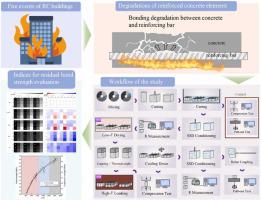当前位置:
X-MOL 学术
›
Constr. Build. Mater.
›
论文详情
Our official English website, www.x-mol.net, welcomes your feedback! (Note: you will need to create a separate account there.)
A simple direct current model for residual bond strength assessment of embedded rebars in thermally damaged concrete
Construction and Building Materials ( IF 7.4 ) Pub Date : 2024-03-19 , DOI: 10.1016/j.conbuildmat.2024.135777 Tsung-Chin Hou , Lili Lorensia Mallu , Kai-Ren Zhan
Construction and Building Materials ( IF 7.4 ) Pub Date : 2024-03-19 , DOI: 10.1016/j.conbuildmat.2024.135777 Tsung-Chin Hou , Lili Lorensia Mallu , Kai-Ren Zhan

|
Fire events are highly fatal to human lives and properties, and should be considered at structural design phases. Concrete structures are essentially fire resistant up to certain level, beyond that structural components would degrade away from their design values. Residual capacities of fire exposed structures should be properly assessed before strengthening tasks can be carried out. Among those, the residual bond strengths between reinforcing bars and concrete are of particular importance because they determine the mechanical performance of all reinforced concrete components. This study focused on proposing novel nondestructive approaches to assess the residual bond strengths after thermal exposures. Specifically, a simple direct current (DC) model was implemented to yield electrical resistivity indices that can closely reflect the bond strength degradations up to 400 ℃. DC polarization measurements were split into three phases through which each index induced the degradations differently. Capability and efficiency of the DC indices to assess residual bond strengths of thermally damaged concrete were analyzed and discussed. Results presented have suggested that the proposed DC approach performed better than using residual compressive strengths to assess residual bond strengths, and was more advantageous for its nondestructive features.
中文翻译:

用于热损伤混凝土中嵌入钢筋残余粘结强度评估的简单直流模型
火灾事件对人类生命和财产具有极高的致命性,应在结构设计阶段予以考虑。混凝土结构基本上具有一定程度的耐火性,超过该水平,结构部件就会退化而偏离其设计值。在执行加固任务之前,应正确评估暴露在火灾中的结构的剩余能力。其中,钢筋和混凝土之间的残余粘结强度特别重要,因为它们决定了所有钢筋混凝土构件的机械性能。这项研究的重点是提出新的无损方法来评估热暴露后的残余粘合强度。具体来说,采用简单的直流 (DC) 模型来生成电阻率指数,该指数可以密切反映高达 400 ℃ 的粘合强度下降情况。直流极化测量分为三个阶段,每个阶段都会导致不同程度的退化。分析和讨论了 DC 指数评估热损伤混凝土残余粘结强度的能力和效率。结果表明,所提出的 DC 方法比使用残余压缩强度来评估残余粘合强度的效果更好,并且因其无损特性而更具优势。
更新日期:2024-03-19
中文翻译:

用于热损伤混凝土中嵌入钢筋残余粘结强度评估的简单直流模型
火灾事件对人类生命和财产具有极高的致命性,应在结构设计阶段予以考虑。混凝土结构基本上具有一定程度的耐火性,超过该水平,结构部件就会退化而偏离其设计值。在执行加固任务之前,应正确评估暴露在火灾中的结构的剩余能力。其中,钢筋和混凝土之间的残余粘结强度特别重要,因为它们决定了所有钢筋混凝土构件的机械性能。这项研究的重点是提出新的无损方法来评估热暴露后的残余粘合强度。具体来说,采用简单的直流 (DC) 模型来生成电阻率指数,该指数可以密切反映高达 400 ℃ 的粘合强度下降情况。直流极化测量分为三个阶段,每个阶段都会导致不同程度的退化。分析和讨论了 DC 指数评估热损伤混凝土残余粘结强度的能力和效率。结果表明,所提出的 DC 方法比使用残余压缩强度来评估残余粘合强度的效果更好,并且因其无损特性而更具优势。



























 京公网安备 11010802027423号
京公网安备 11010802027423号